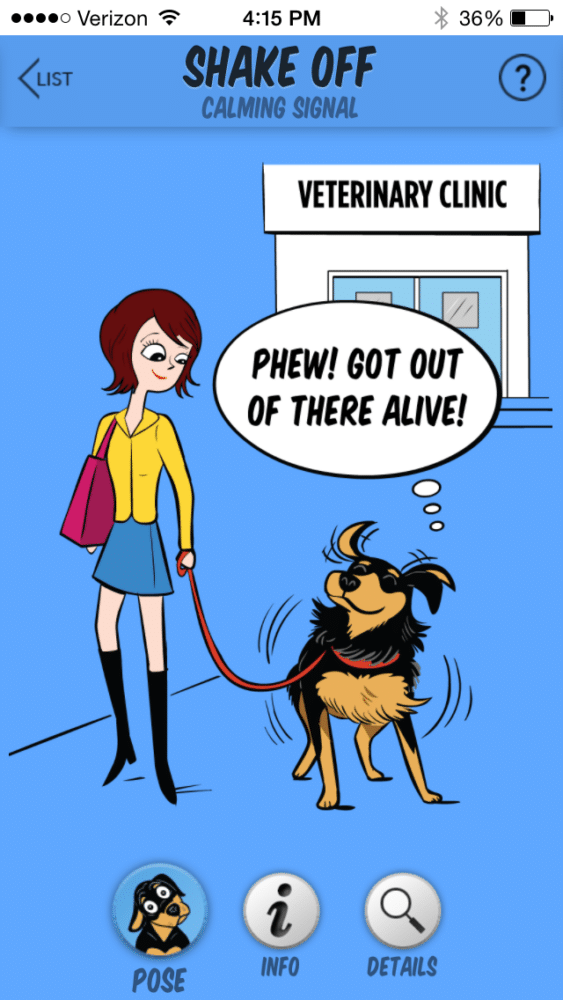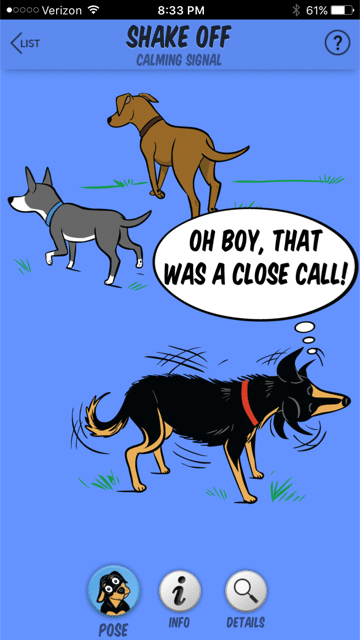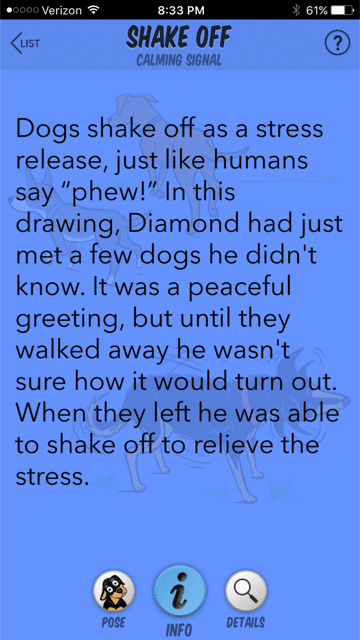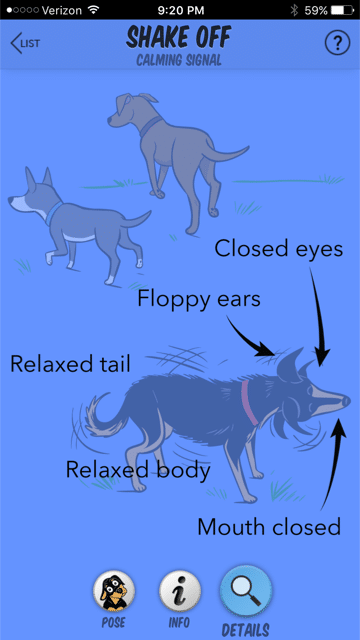Dogs shake off for a wide variety of reasons. Some do it when they wake up. All do it when they get wet. The “shake off” to watch out for, though, is the one that signals stress, anxiety or arousal. It means they are uncomfortable with what just happened. I translate this body language in my Dog Decoder smartphone app, using illustrations by Lili Chin of Doggie Drawings.
In the image below, you see Diamond (star of the app) shaking off outside the veterinary clinic. Even though it may have been a routine exam, many dogs find going to the vet, stressful. Other shake-off triggers include interacting with other dogs, greeting new children and adults, being in busy places, riding in the car or taking part in training. Once you start watching out for shake offs, you may realize that your dog shakes off a lot. Knowing this, you’ll be able to reassure them by taking it more slowly in such situations. Let’s take a look at other shake-off scenarios.

Why Buffet did the shake off
Recently, I worked with a pup who was from the shelter in Oroville, California, where the dam broke and everyone was evacuated. He was brought into the shelter very sick and starved. His rescuers weren’t even sure he was going to survive. Survive he did, and now he is growing leaps and bounds, in mind and body. His name is Buffet, and as we began training, I noticed that when we work in the house without a leash, he has a blast, but as soon as I put a leash on him, he shows signs of stress.
He starts barking and grabbing the leash, and all of a sudden he becomes deaf. Ha! At least he wants me to think he is deaf. Noticing this behavior, I took the leash off, and he immediately did the shake off as if to say, “Phew, that was intense, I didn’t like that at all!” I knew I had some desensitizing to do in this area to make him more comfortable. I’m happy to say that tonight, after one week, he was his goofy self while training with the leash on, in our front yard and on the street. No, barking or biting at the leash, and no shake off when we were done. YAY for both of us! I read his body language and he was glad that I did.
So, think of the shake off as how we feel when something very stressful happens but it all turns out well. We take that deep breath, a sigh of relief. I often refer to it as a rebalancing of energy after being stressed, excited or anxious. Dogs do this behavior to regain a sense of balance or peace, too.
Diamond being approached by dogs he doesn’t know
Even though dogs love to play and wrestle with each other, there are times when it gets a little intense and you’ll see them separate while one or both dogs does the shake off. They may resume play after they regain balance, or they may not. Noting this behavior can help you realize when a playdate may need to come to an end. Not doing so can be the cause of a fight. Dogs need breaks, too, so it’s critical that you learn how to read their body language. It can mean the difference between a friendly, playful dog and one who becomes aggressive because we didn’t step in soon enough to relieve them.


In this situation, Diamond uses the shake off plus other body language cues.

Dogs read each other all the time, and we must learn their language, so that we can be their best advocates, keeping them safe and happy.
For more insight, download the Dog Decoder smartphone app via iTunes and Google play. You can also learn more from Sarah Kalnajs’s DVD The Language of Dogs as well as from the book Decoding Your Dog: Explaining Common Dog Behaviors and How to Prevent or Change Unwanted Ones by John Ciribassi, Debra Horwitz and Steve Dale.
About the author: Jill Breitner is a professional dog trainer and dog body language expert. She is a certified Fear Free Professional for Dogs and Cats; as well as Certified in Animal Behavior and Welfare. She is the author of Dog Decoder, a smartphone app about dog body language. Join Jill on her on her Facebook page.





